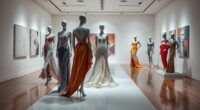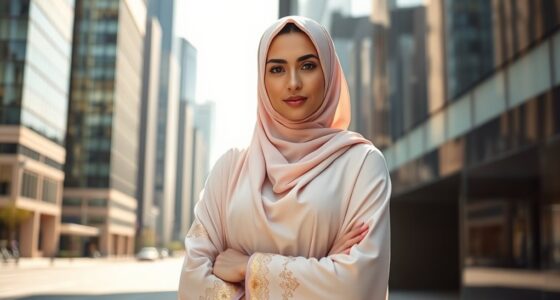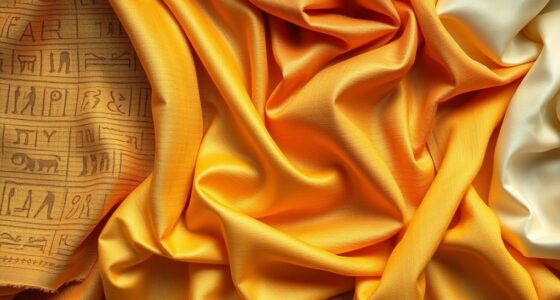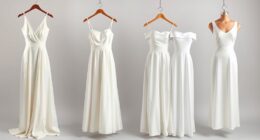Red commands attention in fashion because of its strong psychological and cultural meaning. It’s associated with energy, passion, confidence, and power, which naturally draws the eye. Wearing red helps you stand out and leaves a memorable impression, whether you’re at an interview or a date. Its significance varies across cultures but always signals boldness and assertiveness. To understand how to use this vibrant hue effectively, keep exploring the science behind color in fashion.
Key Takeaways
- Red commands attention due to its association with energy, passion, and confidence in color psychology.
- Its natural eye-catching quality makes red memorable and effective for making bold fashion statements.
- Red conveys assertiveness and enthusiasm, signaling leadership and readiness to stand out.
- Cultural symbolism influences how red is perceived, enhancing its impact in different social and professional settings.
- Strategic use of red in wardrobe choices amplifies personal presence and leaves a lasting impression.
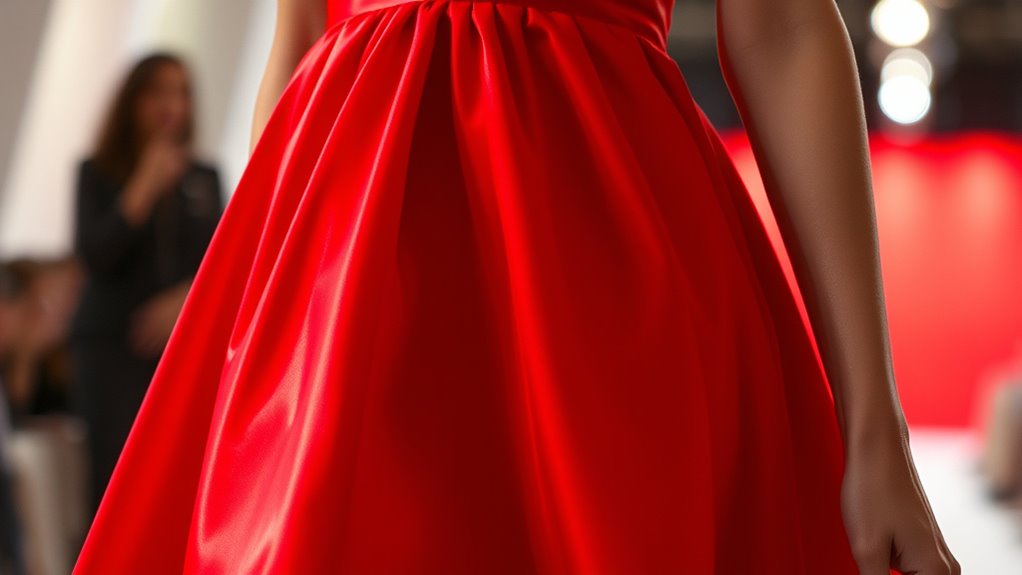
Color plays a vital role in fashion because it influences how you feel and how others perceive you. When you choose a bold red outfit, you’re not just making a style statement—you’re tapping into the powerful sphere of color psychology and color symbolism. These concepts explain why certain hues trigger specific emotions and reactions, making the science of color an essential tool for anyone looking to make an impact through their wardrobe. Red, in particular, commands attention because it’s often associated with energy, passion, and confidence. Wearing red can boost your own sense of empowerment and attract admiration from those around you. This isn’t accidental; it’s rooted in centuries of color symbolism that link red to love, danger, and power across cultures. Understanding these associations helps you leverage the psychological effects of color to communicate your mood or intentions without saying a word. Additionally, the cultural significance of red can influence how your outfit is perceived in different settings, making it important to consider the context when choosing your wardrobe. Color psychology dives deep into how colors influence your mood and behavior. When you wear red, you’re often perceived as assertive, enthusiastic, and even aggressive, which can be advantageous in situations where you want to stand out or assert authority. The vibrant hue naturally draws the eye, making it a favorite for those wanting to leave a memorable impression. Meanwhile, the symbolism tied to red varies but generally revolves around strong emotions—passion, urgency, and vitality. By choosing red, you’re signaling to others that you’re confident, energetic, and ready to take charge. But it’s not just about attracting attention; it’s also about how you feel in red. Many find it invigorating, motivating them to act boldly and face challenges head-on. The significance of color symbolism extends beyond individual perception. Different cultures interpret red in unique ways—celebrating love and prosperity in some, warning of danger in others. This cultural context can influence how your red attire is received, especially in international settings or multicultural environments. Recognizing these nuances allows you to tailor your wardrobe choices to fit the social or professional tone you aim to set. Whether you’re dressing for a job interview, a date, or a public appearance, understanding the underlying meanings of color helps you harness its power intentionally. You don’t just wear red; you communicate a message subconsciously rooted in collective symbolism and psychological impact. In the world of fashion, mastering the science of color empowers you to craft a look that is both impactful and meaningful, helping you leave a lasting impression.
Frequently Asked Questions
How Does Lighting Affect the Perception of Red Clothing?
Lighting plays a big role in how you perceive red clothing. Lighting illusions and color temperature can make red appear more vibrant or muted. Warm lighting enhances red’s warmth, making it look richer, while cool lighting can dull or alter its shade. So, when you’re choosing red outfits, consider the lighting environment to guarantee your look always turns heads exactly how you want.
Can Color Psychology Influence Consumer Purchasing Decisions in Fashion?
Imagine colors as storytellers, whispering hue associations that sway your emotions. When you choose bold reds, you’re tapping into powerful emotional responses—passion, urgency, confidence—that influence buying decisions. Color psychology acts like a silent guide, shaping perceptions and desires. You instinctively feel drawn to certain shades, making them more compelling. So, yes, color psychology deeply influences your choices, turning simple fashion into a language of unspoken connection.
Are There Cultural Differences in Red’S Significance in Fashion?
You should recognize that cultural differences impact red’s significance in fashion. In some cultures, red symbolizes luck and prosperity, shaping fashion traditions and how people choose to wear it. Conversely, in other regions, it might represent passion or danger. These cultural symbolisms influence your fashion choices, making red a versatile color that carries different meanings depending on your cultural background, consequently affecting how it’s perceived and styled.
How Do Different Fabric Textures Impact the Appearance of Red?
When you wear red, fabric texture and sheen substantially affect its appearance. Smooth, shiny fabrics like silk or satin enhance the vibrancy, making the red look more striking, while matte textures like cotton or wool create a subtler, muted effect. Texture contrast adds visual interest, so mixing different fabrics can make your red outfit pop even more. Pay attention to fabric choice to maximize the boldness and depth of your red look.
What Are the Latest Technological Advances in Color Production for Fashion?
You’ll find that digital dyeing and nanotechnology pigments revolutionize color production in fashion. Digital dyeing allows precise, eco-friendly color application, reducing waste and enhancing vibrancy. Nanotechnology pigments create more durable, vibrant shades that resist fading over time. These advances enable designers to experiment with complex hues and textures, giving you bolder, more sustainable choices. As a result, your wardrobe can feature richer, longer-lasting colors with minimal environmental impact.
Conclusion
Next time you wear red, remember you’re wielding a color that’s like a magnetic force, pulling eyes and attention your way. Just like a lighthouse guides ships through darkness, red signals confidence and draws people in. Studies show it can increase attraction and influence perceptions. So, embrace the power of color—because when you wear red, you’re not just dressing up, you’re lighting up the room and making a bold statement that’s impossible to ignore.

